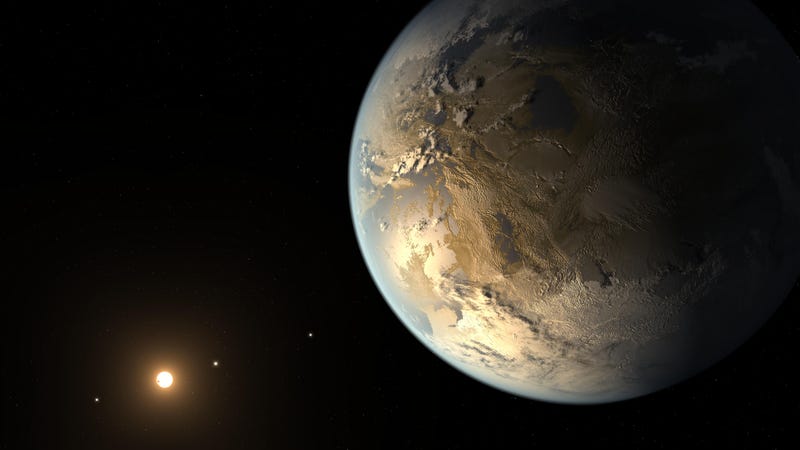 Artist’s conception of Kepler-186f, one of 2,327 confirmed exoplanets discovered by the Kepler Space Telescope. Image: NASA Ames/SETI Institute/JPL-Caltech
Artist’s conception of Kepler-186f, one of 2,327 confirmed exoplanets discovered by the Kepler Space Telescope. Image: NASA Ames/SETI Institute/JPL-Caltech
Unwilling to go quietly into that good night, the Kepler Space Telescope is once again gathering scientific data—despite a malfunctioning thruster and painfully low levels of fuel.
With the $600 million Kepler Space Telescope high atop our dead pool lists, this brief report published yesterday by NASA comes as a rather pleasant and unexpected surprise:
The Kepler spacecraft began collecting science data on Aug. 29 for its 19th observation campaign. After being roused from sleep mode the spacecraft’s configuration has been modified due to unusual behavior exhibited by one of the thrusters. Preliminary indications are that the telescope’s pointing performance may be somewhat degraded. It remains unclear how much fuel remains; NASA continues to monitor the health and performance of the spacecraft.
Incredible. After nine years of active service, a near-death experience in 2013, and 2,327 confirmed exoplanets under its belt, Kepler continues to be the little space-based telescope that could.
Back on August 24, Kepler was put into sleep mode after an anomalous drop in fuel pressure—but not before transmitting data collected during the 18th campaign of the K2 phase of the mission. As the spacecraft hibernated (for the second time in as many months) and possibly waited for death, mission controllers carefully monitored Kepler’s health, trying to figure out if it could participate in another survey, and if so, which functions might still be available.
As it turns out, there’s still some life left in this fighter, with Kepler returning to active duty on August 29—though with some limitations. There’s apparently nothing wrong with Kepler, aside from the low fuel and an issue with one of its eight thrusters. Oh, and the fact that Kepler has only been able to use two of its four reaction control wheels, which it uses to maintain orientation, since 2013.
Artist’s impression of KeplerImage: NASA
“One of the eight thrusters had shown unreliable performance, but the team estimated that simply removing the thruster from use during precision pointing firings could result in acceptable system performance,” Alison Hawkes, a spokesperson at NASA’s Ames Research Center, told SpaceNews. “As a result, the changes were made and Campaign 19 was, as it were, joined in progress.”
The cause of the malfunctioning thruster is not known, but the low fuel may have something to do with it. NASA doesn’t really know. But if other thrusters start to fail, it’s a good sign the low fuel has something to do with it.
With one of eight thrusters shut down, Kepler is now less stable against the incoming solar pressure, making the telescope’s precision pointing performance a bit less… precise. NASA won’t know if Kepler is making observations of any quality until the data gets transmitted back to Earth, which should happen in a couple of months. Unless of course, Kepler runs out of fuel, finally ending the mission that began in 2009. Sadly, Kepler doesn’t come with a fuel gauge, so it’s a bit of a guessing game.

New Report Urges NASA to Intensify Search for Exoplanets and Aliens
A new congressionally mandated report says NASA should refine its strategy and improve its tools to …
Read more Read
The end of the Kepler era is sad, no doubt, but NASA’s Transiting Exoplanet Survey Satellite (TESS) began operations on July 25, 2018. The hunt for distant exoplanets has only just begun.
[NASA, SpaceNews]